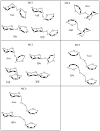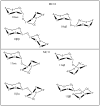CHARMM Drude Polarizable Force Field for Glycosidic Linkages Involving Pyranoses and Furanoses
- PMID: 29694037
- PMCID: PMC5997548
- DOI: 10.1021/acs.jctc.8b00175
CHARMM Drude Polarizable Force Field for Glycosidic Linkages Involving Pyranoses and Furanoses
Abstract
We present an extension of the CHARMM Drude polarizable force field to enable modeling of polysaccharides containing pyranose and furanose monosaccharides. The new force field parameters encompass 1↔2, 1→3, 1→4, and 1→6 pyranose-furanose linkages, 2→1 and 2→6 furanose-furanose linkages, 2→2, 2→3, and 2→4 furanose-pyranose, and 1↔1, 1→2, 1→3, 1→4, and 1→6 pyranose-pyranose linkages. For the glycosidic linkages, both simple model compounds and the full disaccharides with methylation at the reducing end were used for parameter optimization. The model compounds were chosen to be monomers or glycosidic-linked dimers of tetrahydropyran (THP) and tetrahydrofuran (THF). Target data for optimization included one- and two-dimensional potential energy scans of ω and the Φ/Ψ glycosidic dihedral angles in the model compounds and full disaccharides computed by quantum mechanical (QM) RIMP2/cc-pVQZ single point energies on MP2/6-31G(d) optimized structures. Also included in the target data are extensive sets of QM gas phase monohydrate water-saccharide interactions, dipole moments, and molecular polarizabilities for both model compounds and full disaccharides. The resulting polarizable model is shown to be in good agreement with a range of QM data, offering a significant improvement over the additive CHARMM36 carbohydrate force field, as well as experimental data including crystal structures and conformational properties of disaccharides and a trisaccharide in aqueous solution.
Conflict of interest statement
Figures






Similar articles
-
CHARMM additive all-atom force field for glycosidic linkages in carbohydrates involving furanoses.J Phys Chem B. 2010 Oct 14;114(40):12981-94. doi: 10.1021/jp105758h. J Phys Chem B. 2010. PMID: 20845956 Free PMC article.
-
CHARMM Additive All-Atom Force Field for Glycosidic Linkages between Hexopyranoses.J Chem Theory Comput. 2009 Aug 20;5(9):2353-2370. doi: 10.1021/ct900242e. J Chem Theory Comput. 2009. PMID: 20161005 Free PMC article.
-
Polarizable empirical force field for hexopyranose monosaccharides based on the classical Drude oscillator.J Phys Chem B. 2015 Jan 22;119(3):637-52. doi: 10.1021/jp412696m. Epub 2014 Feb 24. J Phys Chem B. 2015. PMID: 24564643 Free PMC article.
-
CHARMM additive all-atom force field for aldopentofuranoses, methyl-aldopentofuranosides, and fructofuranose.J Phys Chem B. 2009 Sep 17;113(37):12466-76. doi: 10.1021/jp905496e. J Phys Chem B. 2009. PMID: 19694450 Free PMC article.
-
Is AMOEBA a Good Force Field for Molecular Dynamics Simulations of Carbohydrates?J Chem Inf Model. 2025 Jun 9;65(11):5289-5300. doi: 10.1021/acs.jcim.5c00442. Epub 2025 May 20. J Chem Inf Model. 2025. PMID: 40392062 Free PMC article. Review.
Cited by
-
Further Optimization and Validation of the Classical Drude Polarizable Protein Force Field.J Chem Theory Comput. 2020 May 12;16(5):3221-3239. doi: 10.1021/acs.jctc.0c00057. Epub 2020 Apr 27. J Chem Theory Comput. 2020. PMID: 32282198 Free PMC article.
-
Extension of the CHARMM Classical Drude Polarizable Force Field to N- and O-Linked Glycopeptides and Glycoproteins.J Phys Chem B. 2022 Sep 8;126(35):6642-6653. doi: 10.1021/acs.jpcb.2c04245. Epub 2022 Aug 25. J Phys Chem B. 2022. PMID: 36005290 Free PMC article.
-
Glycosidic α-linked mannopyranose disaccharides: an NMR spectroscopy and molecular dynamics simulation study employing additive and Drude polarizable force fields.Phys Chem Chem Phys. 2023 Jan 27;25(4):3042-3060. doi: 10.1039/d2cp05203b. Phys Chem Chem Phys. 2023. PMID: 36607620 Free PMC article.
-
CHARMM-GUI Drude prepper for molecular dynamics simulation using the classical Drude polarizable force field.J Comput Chem. 2022 Feb 15;43(5):359-375. doi: 10.1002/jcc.26795. Epub 2021 Dec 7. J Comput Chem. 2022. PMID: 34874077 Free PMC article.
-
TinkerModeller: An Efficient Tool for Building Biological Systems in Tinker Simulations.J Chem Theory Comput. 2025 Mar 11;21(5):2712-2722. doi: 10.1021/acs.jctc.4c01463. Epub 2025 Feb 25. J Chem Theory Comput. 2025. PMID: 39999350 Free PMC article.
References
-
- Alonso DM, Wettstein SG, Dumesic JA. Bimetallic catalysts for upgrading of biomass to fuels and chemicals. Chem Soc Rev. 2012;41:8075–8098. - PubMed
-
- Dwek RA. Glycobiology: Toward Understanding the Function of Sugars. Chem Rev. 1996;96:683–720. - PubMed
-
- Markou G, Angelidaki I, Georgakakis D. Microalgal carbohydrates: an overview of the factors influencing carbohydrates production, and of main bioconversion technologies for production of biofuels. Appl Microbiol Biotechnol. 2012;96:631–645. - PubMed
-
- Dwek RA, Butters TD. Introduction: GlycobiologyUnderstanding the Language and Meaning of Carbohydrates. Chem Rev. 2002;102:283–284.
-
- Slaney AM, Wright VA, Meloncelli PJ, Harris KD, West LJ, Lowary TL, Buriak JM. Biocompatible Carbohydrate-Functionalized Stainless Steel Surfaces: A New Method For Passivating Biomedical Implants. ACS Appl Mater Interfaces. 2011;3:1601–1612. - PubMed
MeSH terms
Substances
Grants and funding
LinkOut - more resources
Full Text Sources
Other Literature Sources
